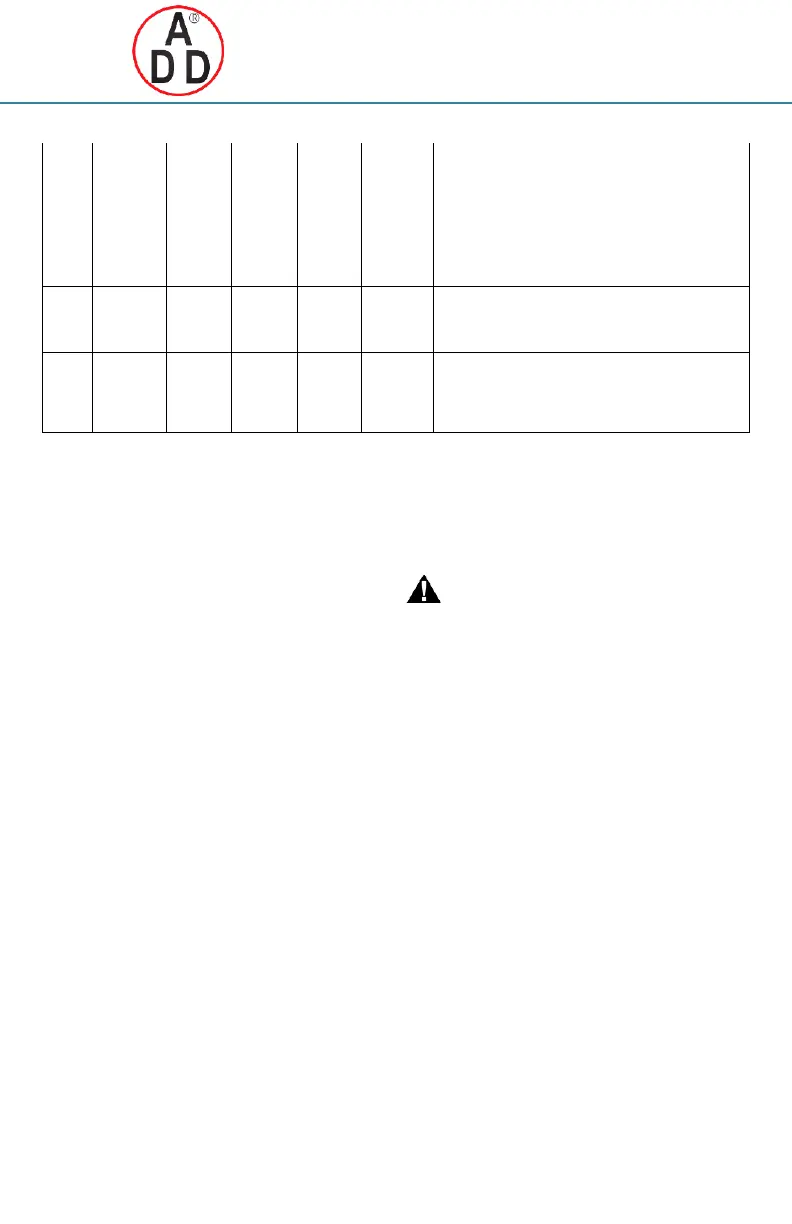S8600B,C,H,M; S8610B,C,H,M; S8670D,E,J,K INTERMITTENT PILOT GAS IGNITION CONTROL
บริษัท เอดีดี เฟอร์เนส จํากัด
ADD FURNACE CO.,LTD.
44 ซอยบรมราชชนนี 70 ถนนบรมราชชนนี แขวงศาลาธรรมสพน์ เขตทวีวัฒนา กรุงเทพฯ 10170
โทร: 02-888-3472 โทร: ออกแบบ:08-08-170-170 แฟกซ์: 02-888-3258
https://www.add-furnace.com E-mail: sales@add-furnace.com
Table 1. Intermittent Pilot Ignition Models. (Continued)
Valve
Current
Rating
@ 24 Vac
Ignition Sequence Description
a
1.0 A Pilot
and
2.0 A Main
15 or 90
seconds,
as ordered
After prepurge, spark and pilot gas ON until lightoff or trial for
ignition ends. If pilot fails to light, pilot gas and spark OFF
(100% shutoff). After 5 minute delay, a new trial for ignition is
initiated. This sequence continues until lightoff or “Call for Heat”
is removed.
1.0 A Pilot
and
2.0 A Main
15 or 90
seconds,
as ordered
After prepurge, spark and pilot gas ON until lightoff or trial for
ignition ends. If pilot fails to light, pilot gas and spark OFF
(100% shutoff), and lockout. Cycle “Call for Heat” to restart
ignition sequence.
1.0 A Pilot
and
2.0 A Main
15 or 90
seconds,
as ordered
After prepurge, spark and pilot gas ON until lightoff or trial for
ignition ends. If pilot fails to light, pilot gas and spark OFF
(100% shutoff). After 5 minute delay, a new trial for ignition is
initiated. This sequence continues until lightoff or “Call for Heat”
is removed.
a
If established flame is lost, all models restart ignition trial.
b
Separate: two rod; remote flame sensing.
c
Combination: one rod; local flame sensing.
All models provide:
•
Natural or LP gas.
•
Pilot burner ignition using a high voltage spark.
•
Flame rectification circuit to monitor flame presence.
•
Monitoring of 24 Vac, pilot, and main gas valve.
•
LED indicator for flame presence/strength and system
status/errors.
•
Connections for flame reading via standard micro-
ammeter.
•
Optional: Alarm Output dry contacts (Lockout models
Only).
SPECIFICATIONS
Control Voltage:
24V (18-30 Vac) 50/60 Hz
Current Draw:
0.1 A plus valve load @ 24Vac
Trial for Ignition:
15 or 90 seconds (depends on model)
Prepurge:
See Table 1.
Ignition Sequence:
See Table 1.
Retry Delay:
5 minutes (C, M, E, and K models only)
Flame Failure Response Time:
2 seconds maximum
LED:
The green status LED provides system status, error
codes, and flame strength indication when in run
mode.
Gas Control:
Honeywell models VR8204 and VR8304
Operating Temperature:
Minimum ambient temperature rating is -40°F (-40°C).
Maximum ambient rating for S8600 used with 1.0A
main valve is 175°F (79°C).
Maximum ambient rating for S8610 and S8670 used
with 2.0A main valve is 165°F (74°C).
Relative humidity:
0% to 95% noncondensing
PLANNING THE
INSTALLATION
WARNING
Fire or Explosion Hazard.
Can cause severe injury, death or property
damage.
1.
Plan the installation as outlined below.
2.
Plan for frequent maintenance as described in
the Maintenance section.
Intermittent pilot systems are used on a wide variety of
central heating equipment and on heating appliances
such as commercial cookers, agricultural equipment,
industrial heating equipment and pool heaters. Some of
these applications may make heavy demands on the
controls, either because of frequent cycling, or because of
moisture, corrosive chemicals, dust or excessive heat in
the environment. In these situations, special steps may be
required to prevent nuisance shutdowns and premature
control failure. These applications require special
Honeywell review; contact your Honeywell Sales
Representative for assistance.
Review the following conditions that can apply to your
specific installation and take the precautionary steps
suggested.
Frequent Cycling
These controls are designed for use on appliances that
typically cycle three to four times an hour only during the
heating season. In year-round applications with greater
cycling rates, the control can wear out more quickly;
perform a monthly checkout.
Water or Steam Cleaning
If the control gets wet, replace it. If the appliance is likely
to be cleaned with water or steam, protect (cover) the
controls and wiring from water or steam flow. Mount the
controls high enough above the bottom of the cabinet so
they do not get wet during normal cleaning procedures.
Use a NEMA 4 enclosure for the ignition control.

